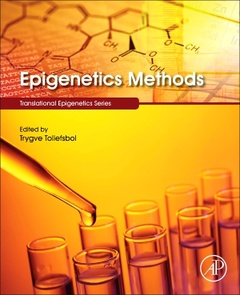Description
Epigenetics Methods
Translational Epigenetics Series
Coordinator: O Tollefsbol Trygve
Language: English
Keywords
Epigenetics Methods; DNA Methylation; Methylation Analyses; Bisulfite Conversion; Methylation-specific PCR; Pyrosequencing; Matrix-assisted Laser Desorption; Time-of-Flight Mass Spectrometry; Droplet Digital qPCR; Methylomic Analyses; ELISA; Global Methylation Levels; Bisulfite Sequencing; RRBS; Immunoprecipitation; Enzyme Sequencing; MRE-seq; Enzymatic Activity; 5-Hydroxymethylcytosine; Chromatin Immunoprecipitation; ChIP; ChIP-qPCR; Deep Sequencing; Histone Modifications; ChIP-seq Analyses; Sequential ChIP; Chromatin Structures; FAIRE-seq; Chromatin Analyses; chromatin-nuclear architecture; Chromatin Contacts; Epigenetic Gene Regulation; MicroRNAs; miRNAs; miRNAs Profiling; Long Noncoding RNAs; lncRNAs; RNA Binding Proteins; RNA Immunoprecipitation; RIP-seq; Chromatin Isolation; RNA Purification; CHIRP; CRISPR/Cas9; Epigenome-wide Association Study; EWAS; Forensic Epigenetics
736 p. · 19x23.3 cm · Paperback
Description
/li>Contents
/li>Readership
/li>Biography
/li>Comment
/li>
In recent years, the field of epigenetics has grown significantly, driving new understanding of human developmental processes and disease expression, as well as advances in diagnostics and therapeutics. As the field of epigenetics continues to grow, methods and technologies have multiplied, resulting in a wide range of approaches and tools researchers might employ.
Epigenetics Methods offers comprehensive instruction in methods, protocols, and experimental approaches applied in field of epigenetics. Here, across thirty-five chapters, specialists offer step-by-step overviews of methods used to study various epigenetic mechanisms, as employed in basic and translational research. Leading the reader from fundamental to more advanced methods, the book begins with thorough instruction in DNA methylation techniques and gene or locus-specific methylation analyses, followed by histone modification methods, chromatin evaluation, enzyme analyses of histone methylation, and studies of non-coding RNAs as epigenetic modulators. Recently developed techniques and technologies discussed include single-cell epigenomics, epigenetic editing, computational epigenetics, systems biology epigenetic methods, and forensic epigenetic approaches. Epigenetics methods currently in-development, and their implication for future research, are also considered in-depth.
In addition, as with the wider life sciences, reproducibility across experiments, labs, and subdisciplines is a growing issue for epigenetics researchers. This volume provides consensus-driven methods instruction and overviews. Tollefsbol and contributing authors survey the range of existing methods; identify best practices, common themes, and challenges; and bring unity of approach to a diverse and ever-evolving field.
2. Disease in a dish: Cellular models to understand human conditions
3. The Yeast, a versatile model system to study human disease
4. The worm, how can it help?
5. Understanding human genetic disease with the fly
6. The fish as a model for human diseases
7. The mouse model
8. Large animal models of rare genetic disorders
9. Crisper/Cas technology
10. Integrative modeling and novel technologies in human genomics
Human geneticists; human genomicists; translational researchers in genomic medicine, epigenetics, aging, developmental and molecular biology; life science researchers; oncologists; immunologists; bioengineers; developmental biologists; pharmacologists in industry and academia
- Includes contributions by leading international investigators involved in epigenetic research and clinical and therapeutic application
- Integrates technology and translation with fundamental chapters on epigenetics methods, as well as chapters on more novel and advanced epigenetics methods
- Written at verbal and technical levels that can be understood by scientists and students alike
- Includes chapters on state-of-the-art techniques such as single-cell epigenomics, use of CRISPR/Cas9 for epigenetic editing, and epigenetics methods applied to forensics
These books may interest you

Stem Cell Epigenetics 146.54 €

Enzymes of Epigenetics Part B 172.74 €

Enzymes of Epigenetics 172.74 €

